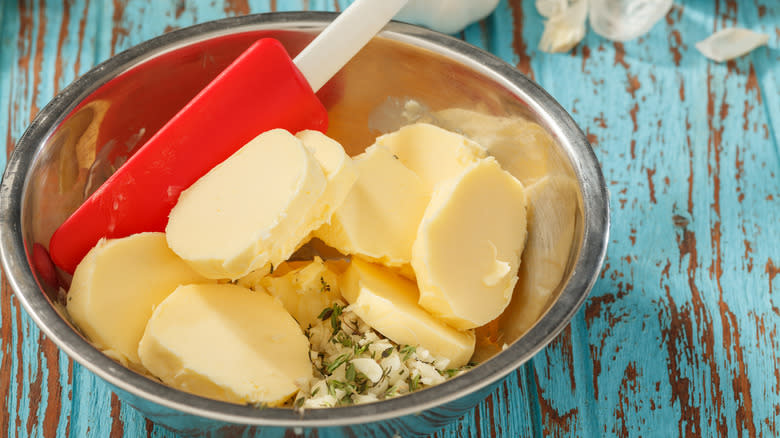Ree Drummond's Ranch Butter Is The Perfect Topping For Steak

There are few things better than a rich, decadent steak. While lots of people choose to enjoy their steak unadorned, topping it with butter can perfectly complement the savory flavor of the meat. Of course, not just any old butter will do. According to popular food personality Ree Drummond, homemade ranch butter is a mighty fine accompaniment when you want to elevate steak to the next level. Drummond's recipe consists of three simple ingredients: Parsley, ranch seasoning, and butter (of course).
This simplified spin on cowboy butter, which pairs butter with herb and spice additions, is easy to make and undeniably delicious. By itself, butter is an excellent topping for steak, as it enhances the savory flavor of the meat and marries nicely with the seared texture. When you incorporate ranch seasoning into the butter topping, you can enjoy an even tastier end result. Ranch seasoning usually consists of dried buttermilk, garlic powder, and sea salt, all of which can bring out the inherent flavors of steak. You can purchase ranch seasoning from just about any grocery store spice aisle, or you can whip up your own. In both cases, this flavorful form of compound butter is sure to gain a place in your recipe hall of fame.
Read more: 11 Of The Best Cooking Tips From Bobby Flay
Best Practices When Whipping Up A Batch Of Compound Butter

Incorporating ingredients into cold, hard butter is pretty challenging. On the other hand, room-temperature butter will be much softer and more pliable, which means you can easily mix in ranch seasoning and parsley. If you want a bold, unforgettable flavor, opt for fresh herbs as opposed to dried ones when possible.
Also, it's best to use unsalted butter in place of salted varieties to ensure you're satisfied with the end result. Using salted butter can alter the flavor profile of your steak topping, while unsalted butter offers the perfect blank canvas for added ingredients. Keep in mind that many brands of ranch seasoning include sodium, so unsalted butter helps keep the flavors balanced. When mixing butter and add-in ingredients, you can use a basic kitchen utensil or a food processor, whatever is easy and readily available. Once fully mixed, you'll need to let the butter harden to ensure it can be easily sliced. For greater convenience, roll the butter in parchment paper and place in the refrigerator until firm. This process typically takes about two hours or so.
How Should You Store Ranch Butter And Other Compound Recipes?

Chances are you'll have some ranch butter left over after topping your juicy, succulent steak. In this case, storing the remainder properly allows you to enjoy it on subsequent occasions. While parchment paper makes it easy to slice butter once firm, it might not offer the best protection. Instead, place the roll into a reusable container with a sealable lid and put the butter in the refrigerator or freezer. When refrigerated, compound butter can last for one week or more. If you opt for the freezer, be sure to use the butter within one month to ensure optimal food safety and flavor.
While proper storage is key to preserving compound butter, you must also be able to recognize signs of spoilage. Off-putting textures and colors make it clear that your butter has reached the end of its lifespan. Spoiled butter may also give an acrid smell that's hard to ignore. In the event you consume spoiled butter, you may experience health effects like stomach discomfort or even vomiting, according to MedicineNet. While these effects are likely to resolve on their own, it's always better to err on the side of caution and prepare a new batch of ranch butter if you're not sure. Once you've tried it on steak, the sky's the limit to what you can pair it with next!
Read the original article on Daily Meal.


